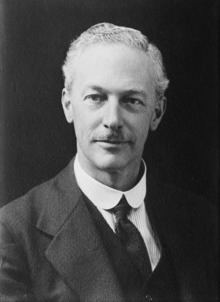Nationality British | ||
 | ||
Spouse Janet Finlay (married about 1898, Scotland) Died 1 February 1951, Westminster, United Kingdom Notable award Fellow of the Royal Society | ||
Sir Eustace Henry William Tennyson d'Eyncourt, 1st Baronet, KCB, FRS (1 April 1868 – 1 February 1951) was a British naval architect and engineer. As Director of Naval Construction for the Royal Navy, 1912–1924, he was responsible for the design and construction of some of the most famous British warships. On 20 February 1915 Winston Churchill appointed him Chairman of the Landships Committee at the Admiralty, which was responsible for the design and production of the first military tanks to be used in warfare.
Contents
Personal life
Tennyson D'Eyncourt was born in April 1868 at Hadley House, Barnet, Hertfordshire. He was the sixth child of Louis Charles Tennyson-D'Eyncourt (1814–1896) and his wife Sophia Yates (d. 1900). Through his father, he was a cousin of Alfred, Lord Tennyson.
He was educated at Charterhouse before becoming an apprentice in naval architecture at the shipyard of Armstrong, Whitworth & Co. in Elswick. By 1898, he was employed as a naval architect in Govan, Glasgow. There he met Janet Burns (née Watson Finlay), a widow whom he married that same year. She had two children from her first marriage, Kingsley and Gwyneth; together she and Tennyson D'Eyncourt would also have a son and daughter, Cecily and Gervais. Janet Tennyson D'Eyncourt died in 1909 when accompanying her husband on a business trip to Buenos Aires.
He received a number of awards and honours: in 1921, he was elected to the Fellowship of the Royal Society, in 1930, he was created a baronet, and was elected a fellow of the Royal Society of Arts in 1946. Tennyson D'Eyncourt was succeeded in the baronetcy by his son Gervais (d. 1971). His great-grandson is the writer Adam Nicolson.
Career
As an apprentice at Armstrong, Whitworth & Co., Tennyson D'Eyncourt worked on the design of warships for the Austrian, Italian, Norwegian, Spanish, Portuguese, and Turkish governments. He joined the Fairfield Shipbuilding and Engineering Company of Govan in 1898, before returning to Armstrong, Whitworth & Co. in 1902. In 1904, he undertook consultancy work on the state of the Turkish navy which earned him the Order of the Medjidie, Third Class.
In 1912, Tennyson D'Eyncourt was appointed director of naval construction with the Royal Navy. He pioneered new forms of ship construction that helped provide protection from torpedo attack. After the outbreak of the First World War, he was entrusted with designing airships for the navy, and also with undertaking the design of "landships" which could advance through No Man's Land—a machine now better known as a tank.
Tennyson D'Eyncourt resigned from the Admiralty in 1924, rejoining his former company, Armstrong, Whitworth & Co. However, the firm failed in the late 1920s owing to the building slump following the end of the war. In 1928, Tennyson D'Eyncourt joined the board of Parsons Marine Steam Turbine Company until he retired in 1948. He lived for most of his retirement in Hailsham, Sussex, but died in London in 1951.
He is buried in Brookwood Cemetery.
Design characteristics
In his battlecruisers, "large light cruisers" and the Hawkins-class cruisers, d'Eyncourt evolved a novel hull form: in cross-section the hull was an isosceles trapezoid, with the ship's sides sloping inboard at an angle of 10 degrees from the vertical, while outboard of this, external bulges extended over the full length of the machinery spaces. The result was a hull structure of great strength, and the sloping sides increased the possible spread of impact of shells, thus giving greater resistance to penetration.
The aesthetic side of naval architecture has seldom been given much attention, though it is as much of an art as the architecture of buildings; in general appearance (in terms of harmonious proportion as regards length, beam, and freeboard, as well as the size of the superstructure and funnels in relation to the hull), the opinion has been expressed that d'Eyncourt created some of the most elegant and eye-pleasing warships ever designed, the prime example being the battle cruiser Hood.
Ship designs
D'Eyncourt was not necessarily the principal designer of the vessels listed below, but had ultimate responsibility for them.
Battleships and Battlecruisers
Cruisers
"Large light cruisers", later aircraft carriers
Destroyers
Submarines
Other types
Monitors, Patrol boats, Minesweepers, Sloops, Gunboats for China Station, Merchant ship conversions into seaplane carrier
Tanks
D'Eyncourt was chairman of the Landships Committee, created by Winston Churchill, which oversaw the design and production of Britain's first military tanks during World War 1.
Writings
D'Eyncourt summarized his World War I work in an article "Naval Construction During the War", published in Engineering, 11 April 1919, pp. 482–490. He also published an autobiography entitled A Shipbuilder's Yarn (London: Hutchinson, 1948).
